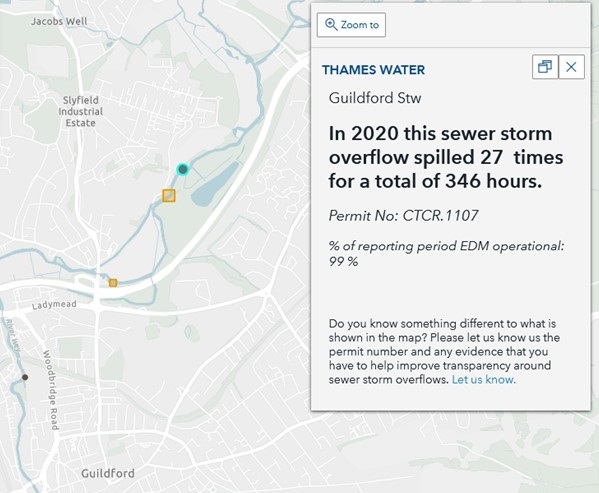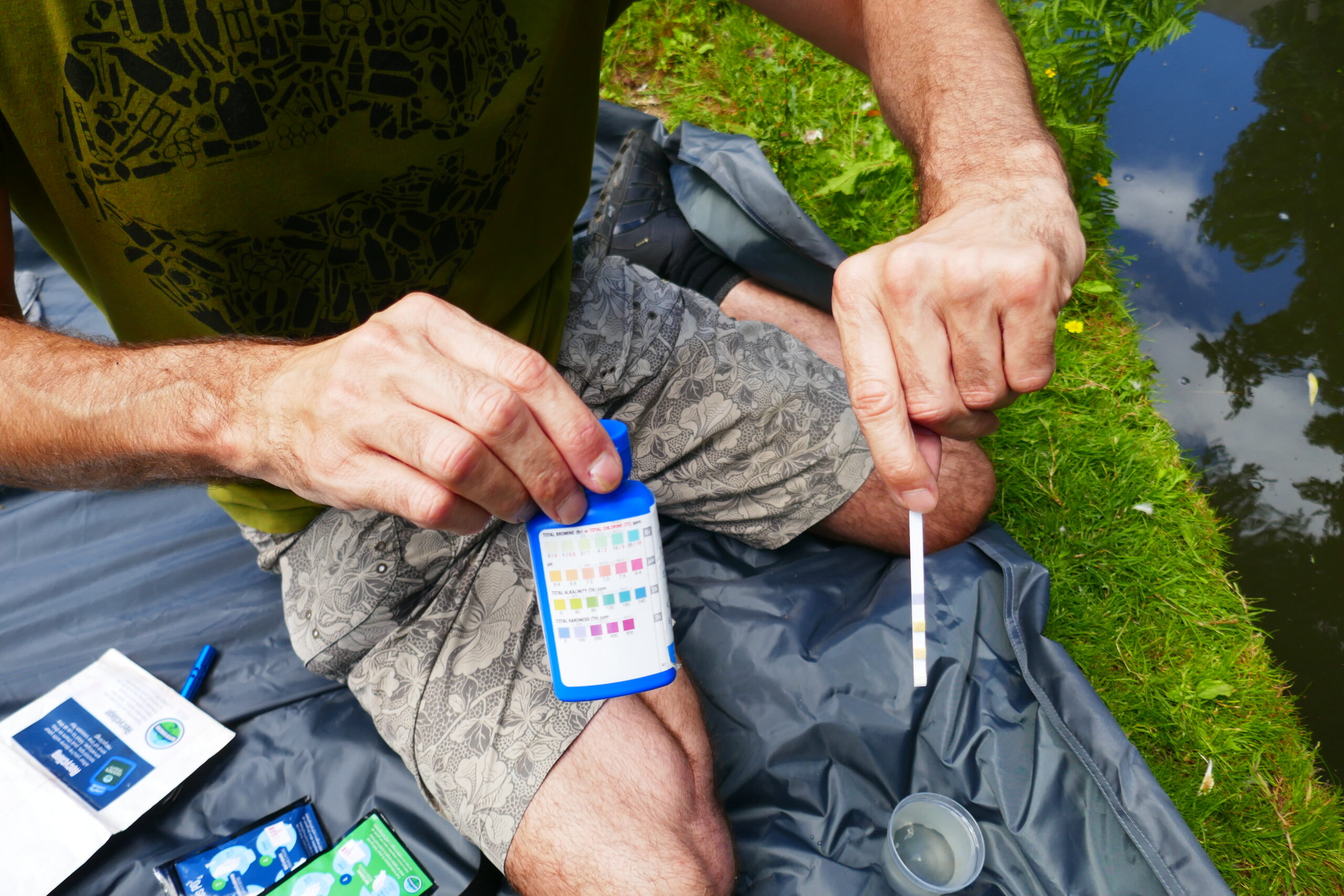 Abraham Lincoln
If given the truth, the people can be depended upon to meet any national crisis...
Abraham Lincoln
If given the truth, the people can be depended upon to meet any national crisis...
 Guildford news...
for Guildford people, brought to you by Guildford reporters - Guildford's own news service
Guildford news...
for Guildford people, brought to you by Guildford reporters - Guildford's own news service
Citizen Scientists Show River Wey Nitrate Levels Three Times Higher At Sewage Works
Published on: 13 Jul, 2022
Updated on: 13 Jul, 2022
By Hugh Coakley
Initial results from a programme of water quality monitoring on the River Wey by local citizen scientists show nitrate levels are three times higher downstream of the Slyfield sewage treatment works than upstream.

Some of the 20 volunteer citizen scientists who are carrying out monthly water quality tests at five locations on the River Wey around Guildford, pictured here at St Catherines. Photo from the Zero Carbon website.
This is raising eyebrows amongst the volunteers who have started carrying out monthly tests of water quality in the river because of pollution concerns.
Alan Thorogood, one of the organisers from Zero Carbon who initiated the testing programme with the River Wey Trust and Water Rangers, said: “It’s clearly coming from the sewage works. We want to find out more and know why.”
The programme of testing the water comes in the wake of concerns about water companies discharging sewage into rivers after certain weather events, such as prolonged periods of heavy rain. The Environment Bill 2021 tightens up on this by saying water companies “must secure a progressive reduction in the adverse harm” caused by sewage dumps.

Data from The Rivers Trust showing numbers of sewage storm discharges from the Thames Water outfall at the Guildford sewage treatment works (STW) at Slyfield in 2020.
But many are saying this is not enough (see Guildford’s MP Defends Government On Sewage Discharge Into Rivers).
And they have a point says Thorogood. He said: “We are in a rich borough and our river water quality is poor. Its shocking there are no rivers in the UK classified to be clean enough to swim in.
“Our aim is for our river to be cleaned up and designated as a swimming location”
The monthly monitoring at five sites on the Wey tests for temperature, conductivity, nitrates, phosphates, chlorine, pH, alkalinity and water hardness.
The testing kits are designed to be a easy to use as possible. All materials are recyclable.
Thorogood said he likes the term “citizen scientist” as it “accurately describes what we are doing but it’s fun as well”.
They have around 20 volunteers now but they want more so they can test more sites. “If you have a location you think should be tested, please tell us” he said.
They have three months results so far but they want to build up a six month database so they can engage with the water authorities to pressure them for improvements.
“We are arranging for a tour of the Slyfield sewage works to understand more. We want to be involved in the consultation on the new Guildford sewage works so we have to start talking with them now.”
He said people are concerned about the water quality on the river. “When we test, we always get passers by chatting and asking us what we are doing. They always have their tale about the water quality and most people are worried, especially the anglers, kayakers, rowers and swimmers.
“If you want to help, we will give you full training in what to do. Contact us at info@zerocarbonguildford.org and ask to be linked up with the team. We would love to have you join in with this fascinating work.”
We have contacted Thames Water for a comment.
Responses to Citizen Scientists Show River Wey Nitrate Levels Three Times Higher At Sewage Works
Leave a Comment Cancel replyPlease see our comments policy. All comments are moderated and may take time to appear.
Recent Articles
- Guildford Institute’s Crowdfunding Project for Accessible Toilet in its New Community and Wellbeing Centre
- Letter: Guildford – Another Opportunity Missed?
- Letter: GBC’s Corporate Strategy – Where Is the Ambition?
- My Memories of John Mayall at a Ground-breaking Gig in Guildford Nearly Six Decades Ago
- Westborough HMO Plans ‘Losing the Heart of the Street’ Says Resident
- College Invests to Boost Surrey’s Economy and Close Digital Skills Gap
- Community Lottery Brings Big Wins for Local Charities
- GBC Housing Plan Promises ‘A Vibrant Urban Neighbourhood’ Near Town Centre
- Hospital Pillows ‘Shortage’ at the Royal Surrey
- Updated: Caravans Set Up Camp at Ash Manor School


Recent Comments
- Ian Macpherson on Updated: Main Guildford to Godalming Road Closed Until August 1
- Sara Tokunaga on GBC Housing Plan Promises ‘A Vibrant Urban Neighbourhood’ Near Town Centre
- Michael Courtnage on Daily Mail Online Reports Guildford Has Highest-paid Council Officer
- Alan Judge on GBC Housing Plan Promises ‘A Vibrant Urban Neighbourhood’ Near Town Centre
- John Perkins on GBC Housing Plan Promises ‘A Vibrant Urban Neighbourhood’ Near Town Centre
- S Collins on GBC Housing Plan Promises ‘A Vibrant Urban Neighbourhood’ Near Town Centre
Search in Site
Media Gallery
Dragon Interview: Local Artist Leaves Her Mark At One of England’s Most Historic Buildings
January 21, 2023 / No Comment / Read MoreDragon Interview: Lib Dem Planning Chair: ‘Current Policy Doesn’t Work for Local People’
January 19, 2023 / No Comment / Read MoreA3 Tunnel in Guildford ‘Necessary’ for New Homes, Says Guildford’s MP
January 10, 2023 / No Comment / Read More‘Madness’ for London Road Scheme to Go Ahead Against ‘Huge Opposition’, Says SCC Leader
January 6, 2023 / No Comment / Read MoreCouncillor’s Son Starts Campaign for More Consultation on North Street Plan
December 30, 2022 / No Comment / Read MoreCounty Council Climbs Down Over London Road Works – Further ‘Engagement’ Period Announced
December 14, 2022 / No Comment / Read MoreDragon Interview: GBC Reaction to the Government’s Expected Decision to Relax Housing Targets
December 7, 2022 / No Comment / Read MoreHow Can Our Town Centre Businesses Recover? Watch the Shop Front Debate
May 18, 2020 / No Comment / Read More











William Lawrence
July 14, 2022 at 8:04 am
Will the new sewerage plant make a difference and is there any pollution from the landfill at the same place? Also, will the new development, the Weyside urban village affect these levels?
Sam Peters
July 14, 2022 at 8:41 am
We are now also monitoring the Wey in various locations in Godalming, as well as the Tillingbourne in Abinger Hammer and Gomshall, with plans to expand our network further as resources and volunteers allow.
It is shameful that the Wey continues to be in the top 25 per cent of the most polluted rivers in the country, failing on four out of 16 chemical contaminant measures including two deemed “Priority Hazardous”.
Hopefully, this information will allow us to hold those responsible to account and make it impossible for our politicians to ignore or sweep the issue under the rug any longer.
Sam Peters is a former Green Party candidate in local elections
Jim Allen
July 14, 2022 at 8:55 am
This is absolutely no surprise. The registered capacity is 89,810 population equivalent (PE) (2018) while the “paperwork” for the new sewage treatment works (STW) states 92,900 PE being currently treated. And in simple terms will be 18 per cent under capacity by 2027 when and if the new STW is built.
The new STW planning permission is not up before the GBC Planning Committee until September 2022 with many unanswered questions regarding leachate, bank stability and pollution from the new site
It is time reality is accepted; moving the STW is irrational and environmentally damaging. The “old” STW needs rapidly upgrading to meet future demands.
Tim Hoban
July 14, 2022 at 2:35 pm
Ok, 3x more nitrates downstream, but that is meaningless without an absolute value to compare with “good quality” water.
Additionally, the main issue with sewage is its impact on dissolved Oxygen – the reduction of which, has a catastrophic impact on both vertebrate and invertebrate life in the river.
The standard would be to test for Biological Oxygen Demand. If this is too expensive/infeasible then sampling the fauna and scoring against a biotic index would give a good view of river health. That would be a great job for volunteers.